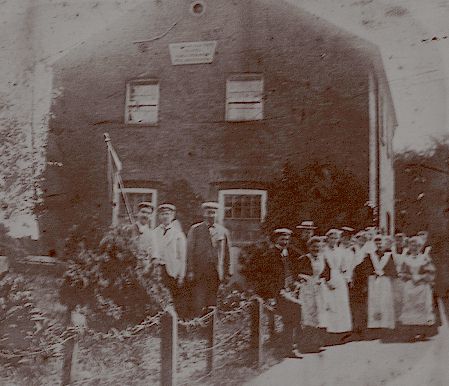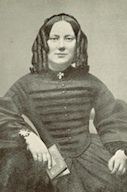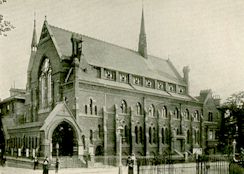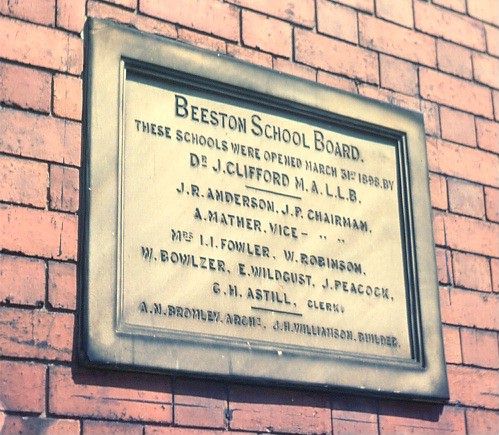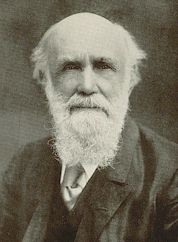| Home Topics Memorials Miscellany Transcripts References Family History Glossary Latest Beeston Blog About us | Site Search |
|
They Had Beeston Connections -John Clifford By the late 18th Century several new challenges had emerged to the Established Church. Methodism, initially a off-shoot from the Church of England but soon to develop in several independent strands competing with each other for followers, had made much of the running. From its start, it had tended to eclipse, at least in popularity, the old non-conformist sects - including the Baptists which had their origins in the early 17th century. Much of this new religious fervour rose out of working class unrest and called for greater democracy and a voice for the many. By the middle of the 18th century, evangelical Baptists in the Midlands, disillusioned by the old General Baptist failure to respond to calls for doctrinal and organisational changes and social reform, had begun to break away from the old Baptist traditions. The focus of this movement was in the hamlet of Barton-in-the Beans which lies close to Market Bosworth in Leicestershire and, as a consequence, these independent Baptists became known as the Barton Society - although affiliated chapels were soon established in other East Midlands villages - notably, Melbourne, in Derbyshire, Keyworth and Loughborough in Leicestershire, and Kirkby Woodhouse, Nottinghamshire. This is the position which was found by one Dan Taylor, a native of Yorkshire and originally a Wesleyan but who, in 1764, had been the driving-force in the building of Birchcliffe Baptist chapel at Hebden Bridge, Yorkshire. When subsequently, the debt on the chapel became too much for the small group, Taylor had set off on foot and was to find both support and a new focus for his efforts and abilities in Leicestershire. Within a year he had guided those Baptists with a like-mind for change - including the Leicestershire group - to form the New Connection of General Baptists. This developed particularly strongly in the Midlands where it opened new churches in towns that were expanding under the influence of the Industrial Revolution. By 1817 it had about 70 chapels. The Connexion had been active in Beeston, but more particularly in Chilwell, since 1800 when Thomas Rogers from Nottingham had begun preaching and encouraging others in the area. The fledging society, was supported at that time by Society members from Ilkeston and met at a house in Chilwell.
John Clifford was actually born in Sawley, a village some 4.5 miles from Beeston, to the south-west, along the Trent Valley in Derbyshire. However, his family moved to Beeston when he was about 4 years old and it was his early-life experiences at school and in the lace factories here that were to have a lasting impression on him and which drove his social conscience. His father, Samuel Clifford, was a upright man yet strict and stern and a hard disciplinarian - a lace maker who had faced the daily toil that that entailed when hand-operation was only then being replaced by steam. In his day, unemployment and high prices had led to riots and demands for reform. Thomas Cooper the Leicester Chartist, became a great influence and he became an active member of the Leicester Chartist Association where Cooper was the leader. John's mother, Mary, was the gentle counter-balance in the marriage. The daughter of John and Elizabeth Stenson, her family background was rooted in the Baptist church in Sawley. She herself had been baptised in the River Trent which flowed adjacent to the village. Her older brother Elam became a Minister and her younger brother, John - in partnership with his wife Sarah - was the master of the Baptist school in Sawley for many years and became the Minister there. She was very much a guiding spirit during John's life. Although both Samuel Clifford and Mary Stenson were born in Sawley and lived there at the start of their married live, their marriage took place in 1836 at Lenton Parish Church in Nottinghamshire. It is likely that Samuel was working in the lace trade there. John Clifford, their first child, was
Increasingly during the early part of the 19th Century, access to education was then being recognised as the way forward and an important part of the social struggle. Pioneers with the Non-Conformist and Evangelical movement within the Church-of-England responded by setting up competing national educational organisations. The British & Foreign School Society was formed in 1814, based on the earlier pioneering Royal Lancastrian Society, to provide nonsectarian, nondenominational schools and teacher training - although, in practice, most of the schools were founded by initiatives by local non-conformists and affiliated to the national organisation. The National School Society had been formed in 1811 to promote Church of England schools and was to become the larger of the two organisations. Government grants, matching local fund-raising began in 1833. Schools associated with factories also developed - and, indeed, some education provision for young workers was a requirement of various Factories Acts from 1802 onwards - in particular in 1844. Taken as a whole, this patch-work provision, with its inherent confliction of religious content became an area of great political contention - a situation which was to continue - and, indeed, to accelerate - as the century progressed.
John Clifford, as we will see, was ultimately to become for ever associated with the struggle for the principle of non-denominational schooling. That was in the future - although the ideas and limited opportunities which he faced as a boy and young man in Beeston must have had a profound influence on him. In Beeston, a National School had been built in 1834 on Brown Lane (on the site where the Fire Station stood until recently, near to Middle Street on the west side of Station Road). It consisted on two wings either side of the master's residence; an infants' classroom was added later. The Wesleyan Methodist opened a competing school on Chapel Street (which ran between Church Street and Middle Street but was displaced when the shopping centre and multi-story car-park were built in the early 1970s). and there was a part-time school for girls at the Silk Mill. While the Clifford family were living in Sawley, they had been able to send John to the local British School which had been founded by the Baptist Church there and where his uncle John Stenson was the master. As the family had moved to Beeston by the time John was four, he must have very young for school by modern standards - although, judging from contemporary census returns, this practice does not appear to have been particularly unusual, much as nursery use is now very widespread. In Beeston, not surprisingly given the family's non-conformist beliefs, the young John Clifford was sent to the Wesleyan School in Chapel Street and was able to attend a Baptist school during the relatively short time the family were living in Lenton. More surprising was his admission to the National School after the family returned to Beeston but, despite the potential clash of religious emphasis, his time there seems to have kindled in him a thirst for learning, as the master - identified by him later in life as a Mr Godler - spoke of Oxford and the world outside the village. This influence, together with his mother's references to her brothers' educational advantages, clearly had an effect on the lad's ambitions. But custom and economic reality took over without any possibility, at that stage, of realising any further ambitions for advancement that the young John Clifford had dreamt of. As was not unusual at that time, when less than eleven years of age, he started the grinding work of the local lace factories. Throughout the rest of his long life her never forgot the drudgery and toil that that entailed - 16-hour day each day, up at four o'clock and continuing through the night on Friday to six o'clock Saturday evening - splicing the cotton on the bobbins to ensure an unbroken thread. Later he moved on to threading and still later, aged 13, graduated to helping one man mind two machines. Later in his life, in scraps of autobiography, he described the relentlessness of these relatively menial tasks and the continual harassment of the foreman who drove them to keep the machines running. Despite this pressure however, John became so adept at his tasks that he began to find time to read while performing his work; when challenged about this, he maintained - and proved - that he could do both and still outperform the other lads. His reading was allowed to continue - the breakthrough that was eventually to provide his way out. Nevertheless, John's health deteriorated under the strain of the demanding factory conditions - but he was one of the lucky ones, able to transfer to outdoor work for the Chilwell nurseryman, John Pearson. After about a year his health was restored enough to consider a move back to the factory - but not, however, back to toil amongst the machines and threads. Instead, at the remarkably early age of 16, he had caught the eye of Robert Felkin and found himself in charge of the lace-mending department at Felkin's Beeston factory, responsible for inspecting the work of 150 woman. Clifford later described Felkin as a fine man and an excellent employer and, in fact, he had come to realise that it was often the evils of the factory system rather than the many good employers that caused such hardship and despair amongst the workers. With Felkin, John found more than a good employer, he had also found a man who took a interest in him and lent him the books he needed to broaden his horizons. In all this, John had the guidance and encouragement of both his parents and the members of the Baptist Church of which his parents were active members and where he therefore attended. His Sunday School teacher, Septimus Thornhill was a particularly strong influence who tutored him in whatever spare time he could find, lent him books - many of which preached the self-help disciplines which were then providing the working classes with new and exciting guiding principles - and filled his mind with ideas. A visit to Nuneaton to visit his uncle, the Revd. Elam Stenson was also to have a great and lasting impression on him. There was a marked contrast between the days of the working week - Monday morning to Saturday evening with no half-day off - and the complete change and relative peace of Sunday when John enjoyed the meetings and services at the Baptist Chapel. It was on one such Sunday, in November 1850, when he was 14 years of age, at the chapel in Beeston that he experienced conversion. In the weeks that followed, he would wander through the fields on the village outskirts, experiencing the joys of nature, sure in his convictions. John was going through was the recognition and profession of faith that the Society required - subject to close examination by the church elders - before acceptance and the subsequent adult baptism that formed the basis and confirmation of full membership. For John, along with ten other persons, that took place on 16th June 1851 - a day that was remembered annually by him to the end of his life. It was a turning point in his life, after which his direction and dedication to his faith never wavered. Soon, he and a few friends began practising preaching with encouragement from the Minister, the Revd Richard Pike, and others who had noticed John's ability. When, after a while, he preached his first sermon at a Beeston service it was well received as he was soon invited join the local Circuit and began to be invited to preach at the surrounding village churches - something he continued to enjoy, when invited, throughout his life although, in these early days at least, it entailed long journeys, often on foot, and in all weathers. His progress over the next two years was noted and well received by the Baptist community in Beeston - a community run on absolute democratic lines where everyone had a say and was listened to - and he won its collective confidence to the point where it was prepared to help the young man move to the next stage - sponsorship to College to prepare for the Ministry. A minute of recorded in their Church records dated April 1855 reads, "J Clifford be recommended to the Academy". An Academy of the New Connexion of General Baptists to provide training for the Ministry had originally been set up in London in 1798 where it remained until 1813 when it moved to Wisbech. It was then under the Revd William Jarrom and later Thomas Stevenson of Loughborough and renamed the Midland Baptist College. After a brief return to London, the Academy moved to Leicester - at Spa Place on Humberstone Road - where it was under Joseph Wallis who stayed until 1857 when the there was a further move to Nottingham. The First World War led to its closure when most of the assets were transferred to Rawdon College, Yorkshire, now the Northern Baptist College. So, it was to Leicester that John Clifford went on entering the College in September 1855. This was the liberating experience he had yearned for after the 'prison' - as he had described it - of Beeston and the factory life that had been his world up to then. Looking back from the perspective of his later life, he was to remember his time spent at the college as the most interesting of his life. He went there with a clear purpose and with the words of his mother ringing in his ears, "John, find out the teaching of Jesus, make yourself sure of that, then stick to it no matter what may come". Two years later he was to leave with a determination and dedication, based on his mother's words, that stayed with him throughout his life's work. In the meantime, there was his studies to concentrate on - including English Language, Sermonising, the Art of Delivery, Church History and Bible Study - and a wider reading and discussion to stimulate his receptive mind. Throughout his time at the Academy he was a popular and confident preacher around the local chapels - including his home chapel in Beeston where the minutes record he was regularly invited. After completing two years of the expected four years at the Academy he received an offer of a pastorate from the membership of Praed Street Chapel in Paddington, London. This was both exciting and unsettling for, as well as the need to complete his training, he had already begun to think about taking his education on to a higher level. After great thought and much advice, he first resolved to refuse the invitation and continue with his studies at the Academy but, when the members at Praed Street repeated their invitation some six months later, he eventually agreed to join them in October 1858. There was, however, an important condition; he was to be permitted to continue with his plans to study for higher degrees. In the same month he commenced studies for a B.A. at London University.
There were soon signs of resurgence; his powerful oratory and tireless activity soon attracted new members and his church and his ministry became a force for spiritual and social progress. John Clifford spent his whole ministry, from 1858 to 1915, with the same community and continued as Pastor Emeritus until his death. He was supported throughout most of this time by a devoted wife and family. The couple had at least seven children; their eldest daughter Kate, who apparently never married, managed the administration of Clifford's office for many years, their next daughter, Edith was a nurse and returned to care for her parents in their last years. Their son Harold became a surgeon, Arthur was an electrical engineer in Nottingham and Sydney, a dental surgeon. Neither did John loose touch with his family and friends in Beeston; when his mother died at the beginning of 1871, his brother Samuel and sisters Elizabeth and Eady were taken into his home in Marylebone, London; Samuel settled in the area and established a plumbing and decorating business which was employing five men and a boy by 1881. But John's vision for his church - and, indeed, the population as a whole, was not limited to spiritual care. He believed in a ministry that addressed the social evils that existed in mid-Victorian England - not least in the urban areas of London where he served - by actively encouraging self-help. Over the next few years he addressed these needs by extending the church's activities into these broader areas to include a Benefit Society, sickness benefit, a Savings Society, a Labour Bureau for job-seekers, a Building Society and - what he saw as the essence of self-improvement - a free adult education institution. The Praed Street initiatives, in effect a mini-Welfare State, became a model for his wider vision of social reform which he pursued relentlessly reaching National prominence and with influence at the highest levels of Government. Within twenty years he led the Baptist Church in England, becoming, in turn, the President of the London Baptist Union (1879), the National Baptist Union (1888) and the Baptist World Alliance. His believe that governments should apply Christian principles when applying their political objectives led him to become an admirer of Gladstone who, he believed, followed that course. In the early days of his ministry, he was a strong supporter of the Liberal Party but, after disagreements over policy and several early temporary withdrawals of support, he finally parted company to support the Labour Party in the 1918 Election. The big issue of this era - and one believed by Clifford to be of critical importance to social justice and individual progress throughout his adult life - was education and he involved himself at every step as the legislation evolved. The 1870 Education Act promised the provision of schools set-up and managed by local school Boards and the Act of 1876 established the principle of elementary education for all children and later Acts took this further. In contrast to the previous voluntary schools - National Schools (which promoted the principles of the Church of England) and British Schools (which tended to be favoured by Non-Confirmist families) - they were non-denominational. Where previously the voluntary schools had been inspected to ensure that, along with everything else, religious teaching followed appropriate denominational lines and those who taught had appropriate briefs, now there was a compromise which excluded all aspects of sectarianism from the religious curriculum, still based on The Bible but which was now allowed to speak for itself. This compromise came under attack from Anglicans in particular who argued that 'undenominationalism' was not the Christian religion and must go. Clifford, a supporter of the compromise fought strongly and publicly to support his principles and beliefs. By 1894 there were calls for a return to religious tests for teachers, a resistance to widening the scope of education further and demands for financial support from the rates for voluntary schools. When an attempt was made to embody these demands into law in 1896, the opposition - led by Clifford and others - was so strong that it was withdrawn. But the controversy did not go away and came to a head once again in the a Bill introduced in 1902 which, while primarily proposed the replacement of the Boards by Council control and to provide for secondary education, once again proposed state funding for the voluntary schools and was seen by many as resulting in a loss of democratic control over schools. Clifford was tireless in his resistance to these aspects of the Bill in particular, speaking against it in meetings up and down the land to overflowing audiences, exercising his political influence and flooding the Press with his concerns. In November 1902 at Alexander Palace, his oratory was met with thunderous applause from the vast, overflowing audience. In May 1903 he spoke to admiring crowds at a demonstration in Hyde Park where hundreds of Free Churchmen had marched to protest against the Bill. In spite of this huge popular resistance, the Bill became law; the controversy and resistance did not, however, go away. The then Liberal Government of 1906 sought to address the grievances with further proposals but these were frustrated by the House of Lords - an issue which found Clifford fighting for its reform in the name of democracy.
In 2011, a blue placque to commemorate his life and work was placed at the original chapel building, on Nether Street West, where he was baptised and preached his first sermon, Click here to read an account of the unveiling. Overall, educational reform eventually led to universal and compulsory education - both primary and secondary - and, although not achieving all his objectives, Clifford had played a major part in the making. One major ingredient still rankled - state funding for denominational education - and this he fought through the Passive Resistance Movement, formed in 1903 by Free Churchmen with Clifford at its heart. The movement's principle too was the withholding that part of the rate which financed sectarian education and many who took part had their belongings distrained and sold and others were given prison sentences. Clifford himself had his belongings sold and was summoned before magistrates many times - in 1922, for the 57th time - and continued the struggle until he died. Clifford involved himself in virtually all major issues of conscience of his era - included opposing the Boer War and the terms of its eventual settlement, calls for the disestablishment of the Church of England, extension of voting rights, Irish Home Rule and the rights of conscientious objectors during the First World War. As a champion of trade unionism he supported the cause in at least two of the landmark employment issues of the day - the matchgirls' fight for better pay and conditions in 1888 and the dockers' strike of the following year. His reputation now extended around the world and he was received with acclaim throughout his travels abroad. After earlier visits on the Continent, he embarked on a World Tour in 1897 with his wife and daughter Edith. In Cape Town he met the Prime Minister, as they did also in Sydney, on to Vancouver and across Canada, everywhere there were deputations, conference, receptions and banquets to attend, everywhere he was keen to see what was being done to educate the people and everywhere they were treated with enthusiasm. In the following years there were more visits to Europe and, in 1911, a visit to the United States where he attended a conference at Lake Mohonk, visited New York where he preached at Fifth Avenue Baptist Church, received an honorary Doctorate from Chicago University, attended a conference of the Baptist World Alliance and visited President Taft at the White House. Then, it was on to Canada where he received another Doctorate from McMaster University before embarking on a cross-Canada tour - including a visit to Calgary where he laid a corner stone of First Baptist Church and where there is also a daughter Westbourne Park Church. Again, he was greeted everywhere with affection and acclaim. In his declining years he was able to attend conferences in Copenhagen and in Germany just as mobilization for War was under way - escaping just in time.
Click the image on the right or here to view a collection of images of Dr Clifford in later life. © David Hallam - 2006 |
|
|||||||||||||||||
|
|
|||||||||||||||||||
